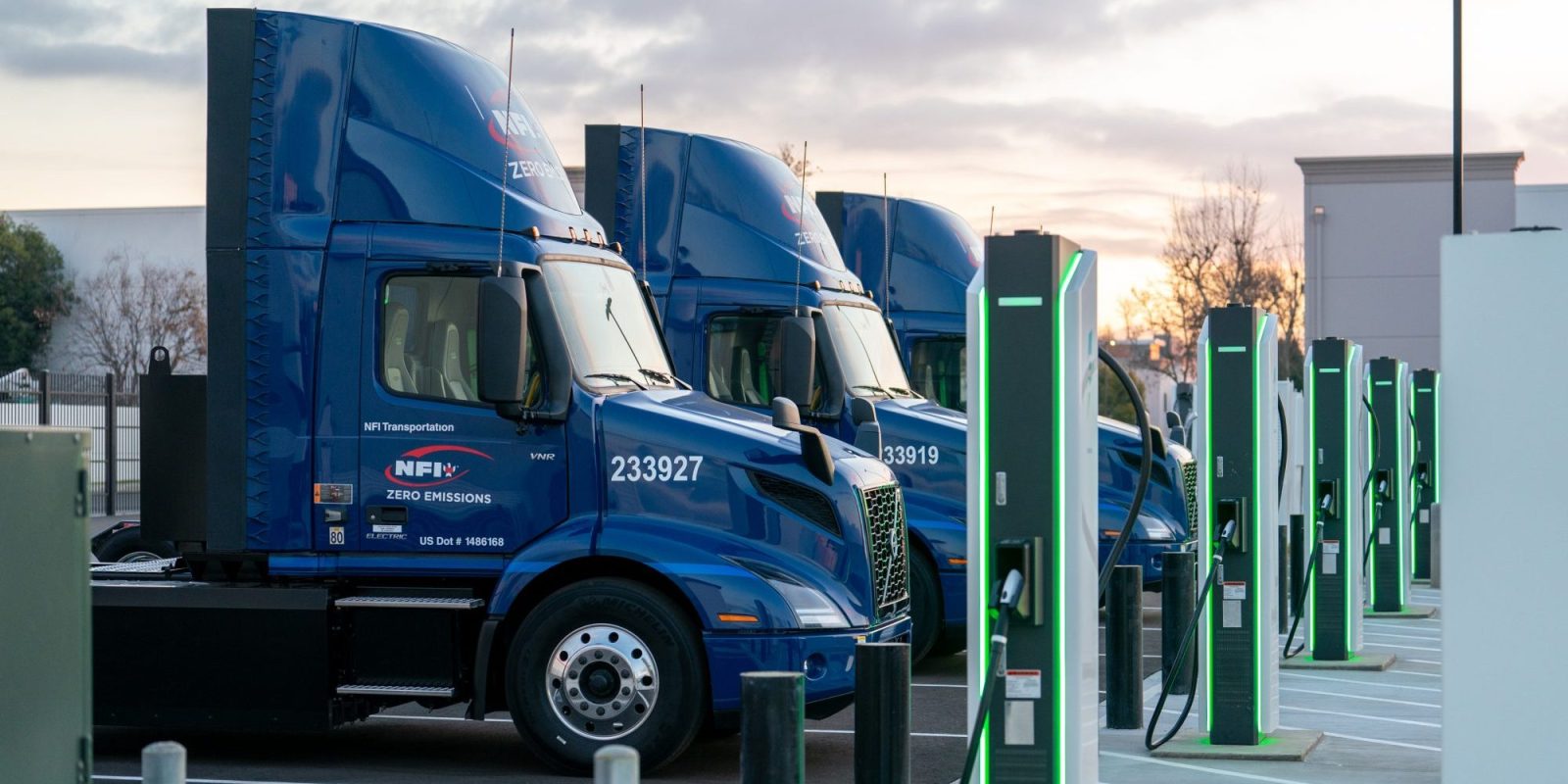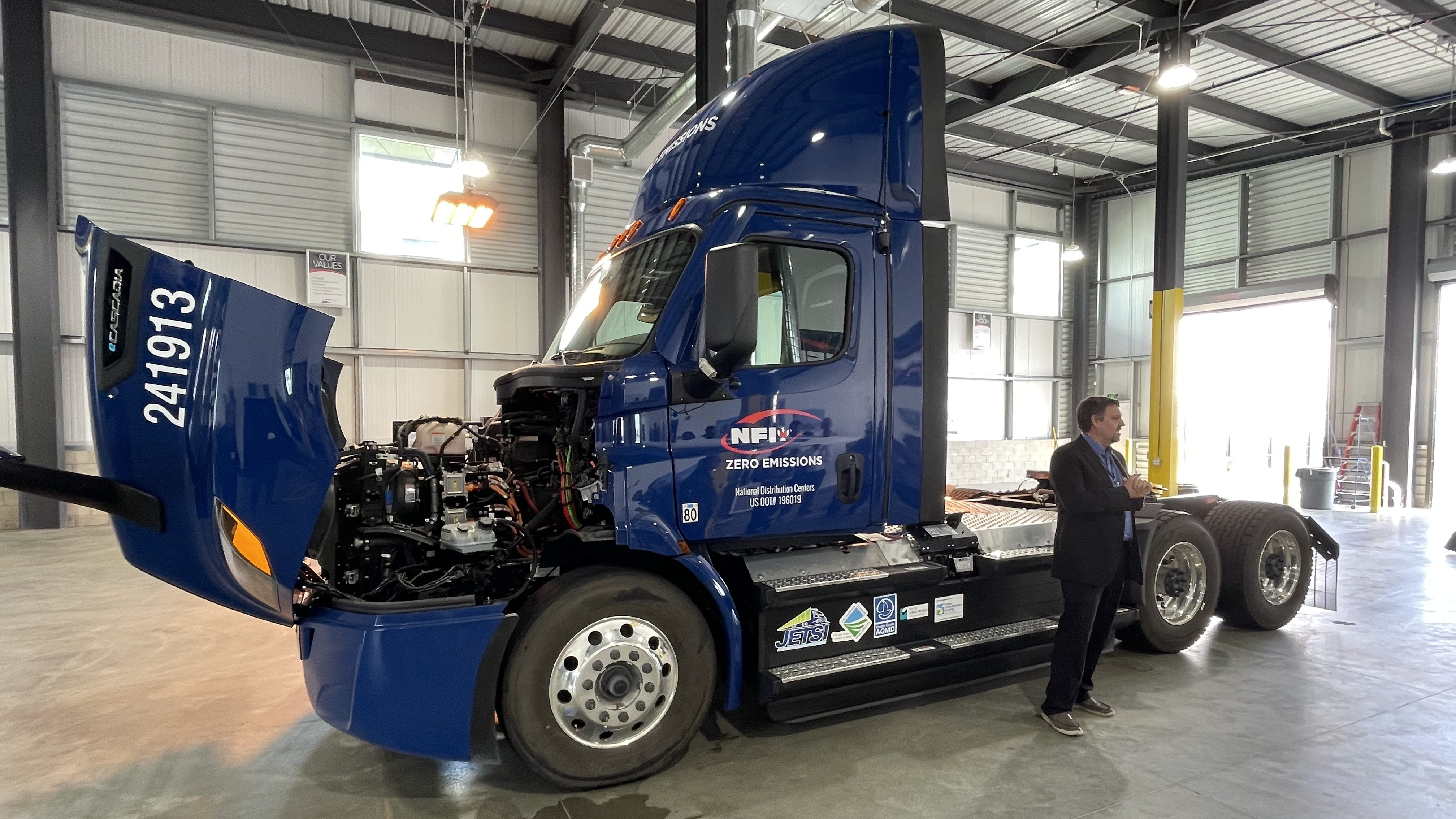
A new 38 port electric truck charging depot and maintenance hub is coming online to service Southern California’s ports and logistics centers, along with 50 new electric trucks from Volvo and Daimler.
Today’s charger opening is part of California’s Joint Electric Truck Scaling Initiative (JETSI), a cooperation between various levels of California government to increase electric truck deployment, particularly in vulnerable communities. This is the second stage of the JETSI project, with the first stage being a 32-port charger opened by Schneider last June.
It’s the first of its kind – that we know of anyway – that functions solely as an electric truck charging hub and maintenance facility. No diesel trucks on this property.
This project is being done with NFI, another supply chain and logistics company which operates across much of North America, in cooperation with Electrify America and Southern California Edison. Today’s 38-port charger project is located in Ontario, near Los Angeles and home to many warehouses and logistics operations to service the nearby ports.
The twin ports of Long Beach and Los Angeles – situated immediately next to each other in Long Beach, California – each accept more containerized traffic than any other port in America. Between the two, roughly 40% of America’s containerized goods come through these ports.
These goods then move on drayage trucks between the ports and California’s Inland Empire, the valley just east of Los Angeles.
As a result, the area is heavily polluted, with logistics traffic being a major contributor. The LA metro area has some of the most-polluted air in the US.
And so, deploying electric trucks here is a huge priority for California government. In California’s new Advanced Clean Fleets rule, these drayage trucks were targeted first – in fact, as of January 1st of this year, you can no longer deploy a new diesel drayage truck in the state. So today’s deployment is no longer all that exceptional in terms of powertrain, but the size and government cooperation make it exceptional.

The California Air Resources Board and California Energy Commission put $27 million in funding into the JETSI project, with additional funds coming from the South Coast Air Quality Management District, Mobile Source Air Pollution Reduction Review Committee, Port of Long Beach, and Southern California Edison. The project is part of California Climate Investments, a program that puts billions of dollars from California’s cap-and-trade funds into service in reducing emissions.
The chargers will be capable of speeds up to 350kW, with about 7MW of combined capacity across the 38 ports. The trucks will include Freightliner’s eCascadia and Volvo’s VNR Electric.
NFI’s charger will also include solar and battery storage, with 1MW of solar and 8MWh of battery storage on-site, though both of these won’t be installed until later this year.
In all, the JETSI project stands to displace 5.5 million gallon-equivalents of diesel fuel over its lifetime, and reduce greenhouse gas emissions by 8,200 tons per year and criteria pollutant emissions by 5 tons per year.
Electrek’s Take
Just like the last time we visited one of these big truck charging hubs, the drive out to the event was quite striking. As we got closer to the site, the freeway got more and more packed with diesel trucks, taking over the road one lane at a time.
And sure enough, driving behind all those diesel trucks is a stinky endeavor. The soot coming from the tailpipes of diesel trucks makes a mess of everything – including, especially, the lungs of nearby communities.

So getting to the charger itself and seeing a nice, new, clean parking lot – and one that will stay that way because there’s not going to be a lot of soot-making, oil-dripping pollution machines hanging around all day – was pretty great. A lot better than the dirty, smelly port of Long Beach, which is currently in the process of cleaning up its act with all these new electric trucks.
But, as we always mention, it’s going to take a lot more depots like this to electrify everything. This is just one project, and the entire Inland Empire is full of truck depots like this.
So this may be a first of its kind, but it’s going to need to be the first of many in order to finally clean up the air around these parts.
FTC: We use income earning auto affiliate links. More.



Comments